Class 9 Economics Chapter 3 Notes - Poverty as a Challenge
Introduction
In our daily life, we see poverty all around us. They could be landless labourers in villages, people living in overcrowded jhuggis in cities, daily wage workers or child workers in dhabas.
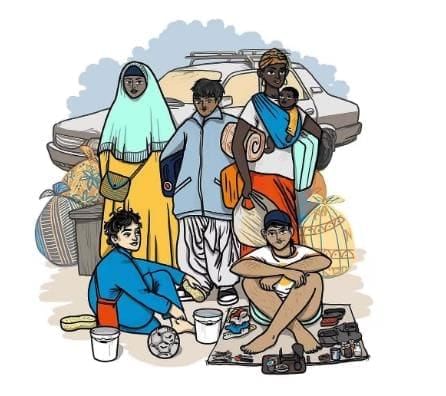 To study this problem, NITI Aayog uses something called the Multidimensional Poverty Index, which looks at poverty in many ways — not just money, but also education, health, and living conditions.
To study this problem, NITI Aayog uses something called the Multidimensional Poverty Index, which looks at poverty in many ways — not just money, but also education, health, and living conditions.
According to this index, poverty in India has reduced over time:
- In 2005–06, about 55% of people were poor.
- In 2015–16, it came down to 25%.
- In 2019–21, it further dropped to 15%.
Experts believe that soon, poverty in India will come down to single digits (less than 10%).
What is Poverty?
Poverty involves hunger and the lack of shelter. It is a situation where parents cannot send their children to school or where sick individuals cannot afford medical care.
Poverty also signifies the absence of clean water and sanitation facilities and a lack of regular employment at a decent minimum level. Those who are poor often face mistreatment in various places, including farms, factories, government offices, hospitals, and railway stations.
Two Typical Cases of Poverty
Urban Case
- Ram Saran, aged 33, works as a daily-wage labourer at a wheat flour mill near Ranchi, Jharkhand.
- He earns about ₹3,500 per month, but only when work is available.
- His income is not enough to support his family of six – his wife and four children aged between 12 years and 6 months.
- He also sends money to his elderly parents living in a village near Ramgarh. His father is landless, and his brother in Hazaribagh also relies on him.
- The family lives in a tiny, one-room rented house on the outskirts of the city, made of bricks and clay tiles.
 Story of Ram Saran
Story of Ram Saran
- His wife, Santa Devi, works as a part-time maid and earns about ₹1,500.
- They manage only two meals a day—mostly dal and rice, which is not enough for all members.
- Their elder son works in a tea shop, earning an additional ₹700.
- The 10-year-old daughter attends school and looks after her younger siblings.
- Each family member has only two sets of old clothes. New clothes are bought only when the old ones are completely worn out.
- Shoes are a luxury they can rarely afford.
- The youngest child enjoys the mid-day meal (dal-rice) provided at school.
Rural Case
- Lakha Singh lives in a small village near Meerut in Uttar Pradesh.
- His family does not own land and works as labourers for big farmers.
- Their work is irregular, and income is uncertain. Sometimes they earn ₹200 for a full day’s work, but often they are paid in kind with wheat, dal, or vegetables.
- The family of six struggles to get even two proper meals a day.
- They live in a kuchha hut on the outskirts of the village.
- The women of the family spend their day cutting fodder and collecting firewood from the fields.
- Lakha’s father had tuberculosis and died two years ago because he couldn’t get treatment.
- His mother now has the same illness and is getting weaker.
- Although there is a primary school in the village, Lakha never went to school, but he is happy that his children do.
- The family gets new clothes only once in a few years.
- Even basic things like soap and oil are a luxury for them.
These two examples show that poverty has many sides. It is not just about having no money. Poverty means:
- being hungry and not having a proper place to live,
- parents not being able to give healthy food to their children three times a day,
- sick people not getting medical help because they can’t afford it,
- not having clean drinking water or proper toilets,
- not having a regular job that pays enough for basic needs,
- living with a feeling of helplessness, where poor people are often treated badly in places like farms, factories, government offices, hospitals, and railway stations.
Clearly, no one would want to live in such conditions.
One of the biggest problems for independent India has been to help millions of people come out of extreme poverty. Mahatma Gandhi said that India would only be truly free when even the poorest people are free from suffering.
Poverty as seen by social scientists
Poverty is not just about having less money, so social scientists use many different ways to understand it. They usually look at income and how much people are able to spend. But nowadays, other factors are also considered to find out if someone is poor.
For example, the National Multidimensional Poverty Index checks poverty using three main things:
- Health – like nutrition, deaths of children and mothers.
- Education – like how many years a person has gone to school and if children attend school regularly.
- Living conditions – like whether the family has clean cooking fuel, toilets, clean drinking water, proper houses, electricity, useful items, and a bank account.
Factors like being left out of society (social exclusion) and facing risks or hardships (vulnerability) are also considered to understand poverty better.
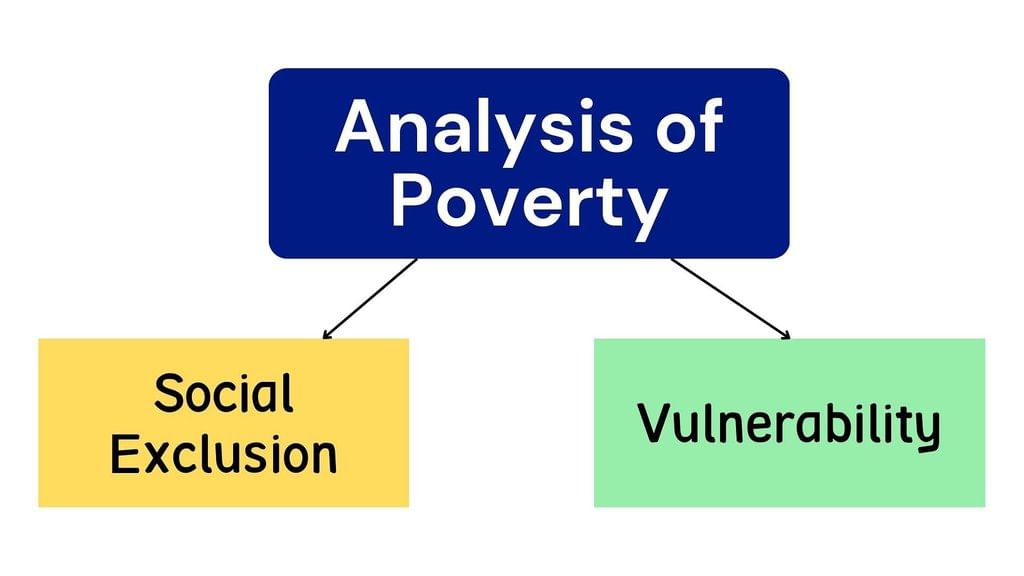 Analysis of Poverty
Analysis of Poverty
Social Exclusion
- Poverty is not just about having less money, but also about living in poor surroundings with other poor people.
- Poor people are often excluded from enjoying the benefits and equal treatment that richer people get.
- This exclusion is called social exclusion.
- Social exclusion can cause poverty or be a result of poverty.
- It means some people or groups are kept away from facilities, benefits, and opportunities that others enjoy.
- A common example is the caste system in India, where people from certain castes don’t get equal chances.
- Social exclusion can sometimes cause more harm than just having a low income.
Vulnerability
- Vulnerability to poverty means the higher chance that some people or groups might become or stay poor.
- Examples include people from backward castes, widows, or those who are physically disabled.
- It depends on what options people have—like their assets, education, health, and job opportunities.
- Vulnerable groups face more risks during natural disasters like earthquakes or tsunamis.
- It also depends on how well they can cope with these risks socially and economically.
- In short, vulnerable people are more likely to suffer worse effects than others when problems like floods, job losses, or disasters occur.
Poverty Line
- The poverty line is a way to decide who is poor and who is not.
- It is usually based on a person’s income or spending on basic needs like food and clothes.
- If someone earns or spends less than a certain amount, they are considered poor.
- The amount needed for basic needs is not the same in all countries or at all times.
- So, each country sets its own poverty line based on its level of development and social standards.
- For example, in the USA, not having a car might be seen as being poor, but in India, having a car is still a luxury.
- In India, the poverty line was earlier decided by calculating the minimum needs like food, clothing, electricity, education, and medical care.
- The cost of these items was calculated using their prices in rupees.
- The poverty line was also linked to the calorie needs of people based on their age, gender, and work.
- On average, a person in rural areas needed 2400 calories per day, and in urban areas, 2100 calories per day.
- Rural people need more calories because they usually do more physical work.
- The money needed to buy enough food to meet these calorie needs was used to set the poverty line.
- This amount is updated regularly as prices of items go up.
- Now, the Government of India also uses something called the Multidimensional Poverty Index.
- This index uses 12 indicators like health, education, and living standards to measure poverty in a more complete way.
- It helps to understand poverty beyond just income or spending.
Poverty Estimates
- Using the method explained earlier, experts calculate the number and percentage of poor people in India. This is called the Head Count Ratio (HCR).
- In the 1990s, the percentage of poor people (based on how much they spent) came down from 45% to 37%, but the total number of poor people stayed around 40 crore.
- Between 2000 and 2011, both the percentage and number of poor people started going down.
- From 2015 to 2021, the percentage of people who were poor in many ways (called multidimensional poor) dropped from 25% to 15%.
- According to official records, about 13.5 crore people came out of multidimensional poverty during this time.
- Also, the reduction in poverty was faster in villages (rural areas) compared to cities (urban areas).
 Estimates of Poverty in India 1993 – 2019
Estimates of Poverty in India 1993 – 2019
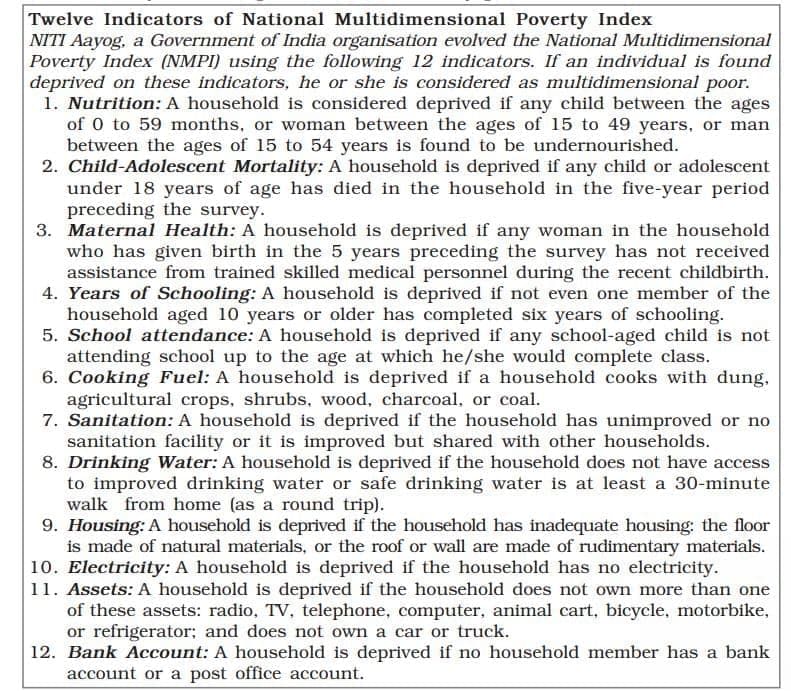 Poverty Index: A Progress Review 2023, NITI Aayog, Government of India.
Poverty Index: A Progress Review 2023, NITI Aayog, Government of India.
Inter-State Disparities
- Poverty is not the same across all states in India; some states have more poor people than others.
- Since the 1970s, poverty has reduced in many states, but the progress is not equal everywhere.
- States like Karnataka, Tamil Nadu, Delhi, Punjab, Himachal Pradesh, Andhra Pradesh, Haryana, and Maharashtra had less than 10% of their population living in poverty in 2019–21.
- States such as Bihar, Uttar Pradesh, Madhya Pradesh, and Rajasthan have also shown great improvement in reducing poverty.
- Different states have used different ways to fight poverty based on their needs.
- Kerala has focused on developing human resources like education and health.
- West Bengal has used land reforms to reduce poverty.
- In Andhra Pradesh and Tamil Nadu, the government has improved the supply of food grains to the poor through the public distribution system.
Vulnerable Groups
- The number of people living below the poverty line varies across different social and economic groups in India. The most affected groups are those from the Scheduled Caste and Scheduled Tribe households.
- In terms of economic status, the groups most at risk are rural agricultural labour households and urban casual labour households.
- While the overall average of people below the poverty line in India is 22%, 43 out of 100 individuals from Scheduled Tribes struggle to meet their basic needs. Additionally, around 34% of casual labourers in rural areas and 29% of those from Scheduled Castes are also poor.

- The severe challenges faced by landless casual wage labour households from socially disadvantaged groups, such as Scheduled Castes or Scheduled Tribes, illustrate the gravity of the issue. Recent studies indicate that, apart from Scheduled Tribe households, all other groups—Scheduled Castes, rural agricultural labourers, and urban casual labour households—have experienced a decline in poverty since the 1990s.
- Women, the elderly, and female infants often lack equal access to resources within their families. Although all family members in poor households face hardship, some experience greater suffering. As a result, women, children (especially girls), and the elderly are among the most impoverished.
Global Poverty Scenario
Is India the only country with poor people?
No, India is not the only country that has poor people. Many other countries also face poverty. To compare poverty between countries, international organisations like the World Bank use a common standard called the poverty line. They consider a person extremely poor if they live on less than $2.15 a day.
You might wonder why the dollar ($) is used instead of the rupee. That’s because every country has its own currency. So, to compare poverty across the world in the same way, international groups use the US dollar as a common measuring unit.
Although poverty has reduced around the world, different regions show different results:
In China and Southeast Asia, poverty dropped a lot because of fast economic growth and large investments in education, health, and skills. In fact, in China, the number of poor people became just 0.1% in 2020.
In South Asia (which includes countries like India, Pakistan, Sri Lanka, Nepal, Bangladesh, Bhutan, Afghanistan, and Maldives), the percentage of poor people went down from 13% in 2017 to 11% in 2021. Also, the number of poor people came down from 233 million in 2017 to 207 million in 2021.
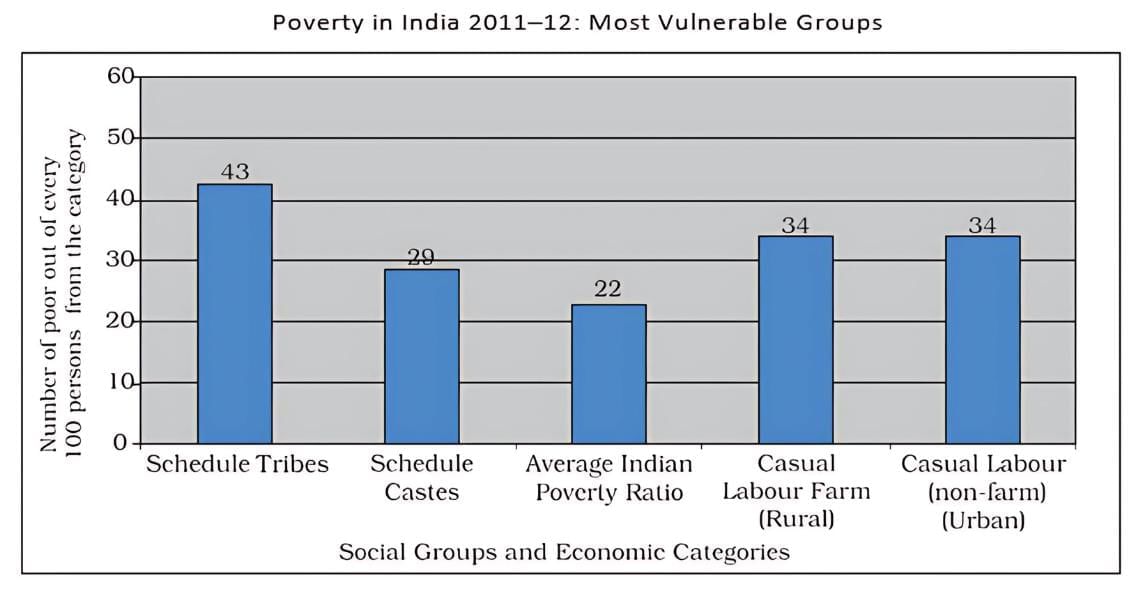
- In Sub-Saharan Africa, poverty also declined slightly — from 36.6% in 2017 to 35% in 2019.
- However, in Latin America and the Caribbean, poverty actually increased slightly, from 4.4% in 2017 to 4.6% in 2021.
- In some former socialist countries like Russia, poverty has also come back. It was 0% earlier, but 3% of people were poor again by the year 2000.
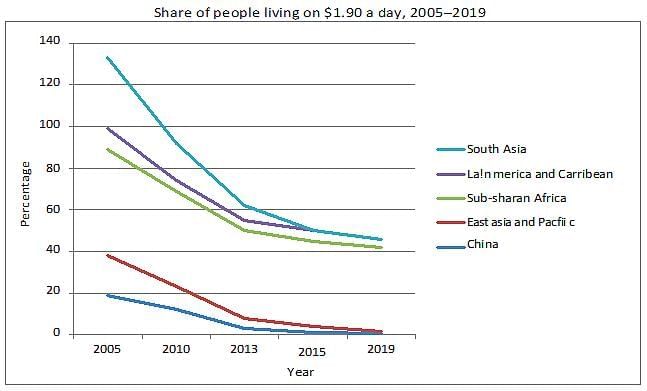
Poverty and Sustainable Development Goals
- The United Nations (UN) has set new Sustainable Development Goals (SDGs) to end all types of poverty by the year 2030.
- These goals are a shared plan to bring peace and prosperity to people and protect the planet—both now and in the future.
- There are 17 goals in total that focus on improving life for everyone.
- To achieve these goals, both rich (developed) and poor (developing) countries need to act quickly and work together.
- Rich countries should help poorer countries by supporting them in ending poverty, improving health and education, reducing inequality, fighting climate change, and promoting sustainable development.

Causes of Poverty
- One major reason for poverty in India is its slow economic growth during British rule.
- The British destroyed local industries like handicrafts and textiles, which led to fewer job opportunities.
- Even after independence, the economy grew slowly until the 1980s, resulting in low incomes and limited jobs.
- The population kept growing, which made the situation worse.
- The Green Revolution helped create some jobs in agriculture, but only in a few regions.
- Industries created some employment, but not enough for everyone.
- Many people moved to cities in search of work but could only find low-paying jobs like rickshaw pullers, vendors, construction workers, or domestic helpers.
- With small and unstable incomes, they couldn’t afford proper homes and started living in slums.
- Poverty, which was once mainly in rural areas, also became a problem in cities.
- There is also a big gap between the rich and poor due to unequal distribution of land and resources.
- Though the government made land reform policies, most states did not implement them properly.

- If these policies had been applied well, they could have helped many poor rural families.
- Social and cultural pressures also lead to poverty. Even poor people spend a lot on weddings, festivals, and religious events, which reduces their savings.
- Small farmers need to buy seeds, fertilizers, and pesticides but have no money, so they take loans at high interest rates.
- When they can’t repay the loans, they fall into debt, which makes their poverty worse.
- So, debt and poverty are connected—each one causes the other.
Anti Poverty Measures
Main Goal: One of India's main development goals has been to reduce poverty.
Government Strategy: The current anti-poverty plan has two main parts
(i) Encouraging economic growth
(ii) Running specific programmes for the poorEarly Situation (1950s to early 1980s):
- India’s per capita income grew very slowly.
- Poverty levels stayed high, around 45%, with little improvement.Change Since 1980s:
- Economic growth increased.
- Growth rate went from 3.5% in the 1970s to 6% in the 1980s and 1990s.
- From 2000 to 2020, India saw even faster economic progress.
- This growth has helped reduce poverty a lot.Link Between Growth and Poverty:
- Economic growth gives more jobs and income opportunities.
- It also gives the government more money to spend on health and education.
- Families are now more likely to send children to school, including girls, hoping for better income in the future.Limitations:
- Poor people may not always benefit from economic growth.
- Growth in the agriculture sector is still very slow.
- Since many poor people live in villages and depend on farming, this affects them directly.Need for Special Programmes:
- Along with growth, we also need targeted programmes to fight poverty directly.
- Many such government schemes exist, some of which are very important and have made a difference.

Mahatma Gandhi National Rural Employment Guarantee Act (MGNREGA), 2005
This scheme was started to give 100 days of paid work each year to every rural household. Its goal is to provide jobs and income in villages, especially during tough times like droughts, deforestation, or soil erosion. One-third of the jobs are reserved for women. The wage rate is regularly updated for unskilled workers.
Pradhan Mantri Poshan Shakti Abhiyan (PM POSHAN)
This is an important programme by the Government of India with two main goals:
To give children nutritious food (with enough calories and protein).
To increase school enrolment and stop children from dropping out of school.
It is for students of Classes I to VIII in government and government-aided schools, and special training centres under the Right to Education Act. The scheme is run with the help of local governments and community groups. It helps poor children attend school more regularly and focus better on studies.
Pradhan Mantri Surakshit Matritva Abhiyan (PMSMA)
Launched in 2016, this scheme aims to reduce the death of mothers and babies by providing free health check-ups and medical care to pregnant women across the country. Services are provided on the 9th of every month. Private doctors are also encouraged to help by volunteering in government hospitals. The scheme ensures safe pregnancies and proper treatment during the pregnancy period.
Pradhan Mantri Ujjwala Yojana (PMUY)
Started in 2016, this scheme helps rural women by giving them clean cooking gas (LPG) instead of using wood, coal, or cow dung. It is for poor families (BPL, SC, ST, forest dwellers, etc.). The LPG connection is given in the name of the woman in the family. The first refill and stove are provided for free.
This scheme helps:
- Reduce air pollution and health problems like breathing issues and weak eyesight.
- Protect the environment by reducing the cutting of trees.
- Save time and effort in collecting firewood.
- Encourage women to take part in work and social activities.
The Challenges Ahead
- Poverty in India has reduced, but it still remains a major challenge.
- There are large differences in poverty levels between rural and urban areas, and also among different states.
- Some social and economic groups are more affected by poverty than others.
- Reducing poverty further will depend on faster economic growth, better education for all, slower population growth, and empowerment of women and weaker sections.
- Measuring poverty only by income shows a limited view and focuses only on survival, not on living well.
- Experts suggest we should also think about human poverty, which includes education, health care, shelter, job safety, confidence, and freedom from discrimination.
- Child labour and caste or gender bias are still issues in some places.
- As countries grow, the idea of what poverty means also changes.
- The chapter explained different ways to measure poverty.
- The National Multidimensional Poverty Index by NITI Aayog shows that fewer people in India are poor in multiple ways now.
- This improvement may be because of various government efforts in recent years.
|
55 videos|525 docs|78 tests
|
FAQs on Class 9 Economics Chapter 3 Notes - Poverty as a Challenge
| 1. What is the poverty line and how is it determined? |  |
| 2. What are some of the vulnerable groups that are most affected by poverty? |  |
| 3. What are some of the main causes of poverty according to social scientists? |  |
| 4. How do anti-poverty measures help in addressing the challenges of poverty? |  |
| 5. How do global poverty estimates compare to inter-state disparities in India? |  |

















